Grab your coffee, social media pros, because we’re diving deep into CloudCampaign, a white-label social media management platform that’s been turning heads in the agency world.
If you’re running a marketing agency, managing multiple clients, or freelancing your way to success, you’ve probably felt the pain of juggling dozens of accounts across different platforms.
CloudCampaign promises to make that chaos disappear. But does it deliver? Let’s find out in this comprehensive CloudCampaign review where we’ll explore everything from its nifty features to its potential pitfalls.
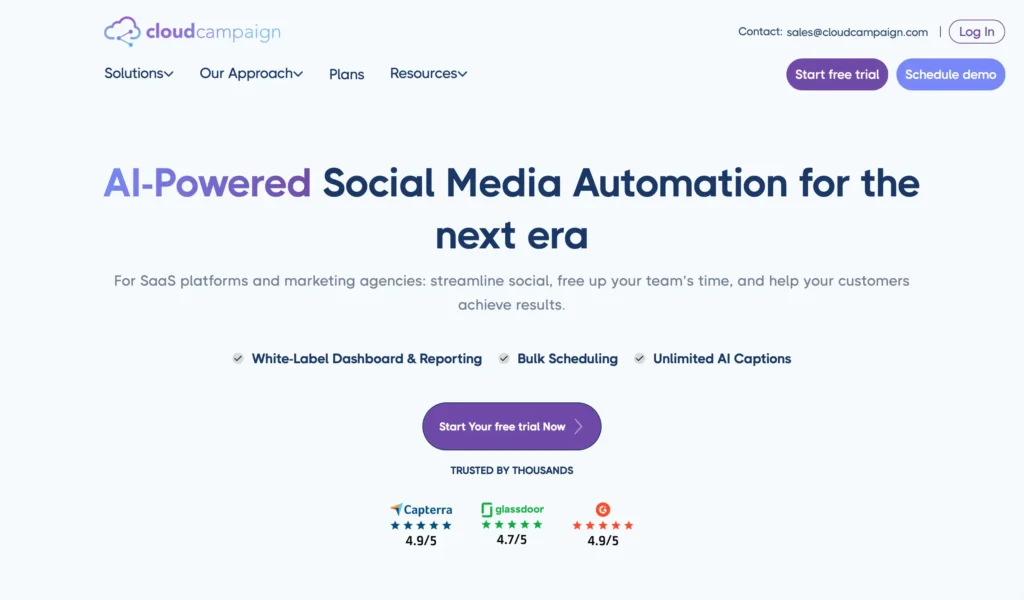
What is a White-Label Social Media Management Software?
Before we plunge into the CloudCampaign deep dive, let’s talk about what white-label social media management software actually means. Think of it as your agency’s secret weapon. Simply put, it’s a platform someone else built, but you get to slap your logo on it and call it your own.
Here’s how it works:
A provider like CloudCampaign builds the entire infrastructure (from the scheduling tools, analytics dashboards, client portals, and reporting features) and then, you rebrand the whole thing with your agency’s colors, logo, and domain name.
Your clients log in and see your brand everywhere, never knowing that a third-party platform powers it all behind the scenes.
This model is revolutionary for agencies because it eliminates the need to spend thousands of dollars developing your own social media management platform from scratch. Instead, you get enterprise-level software for a fraction of the cost, with full customization capabilities that make it look like you built it yourself.
The white-label approach allows agencies to scale rapidly, adding new clients without hiring additional staff or investing in expensive infrastructure.
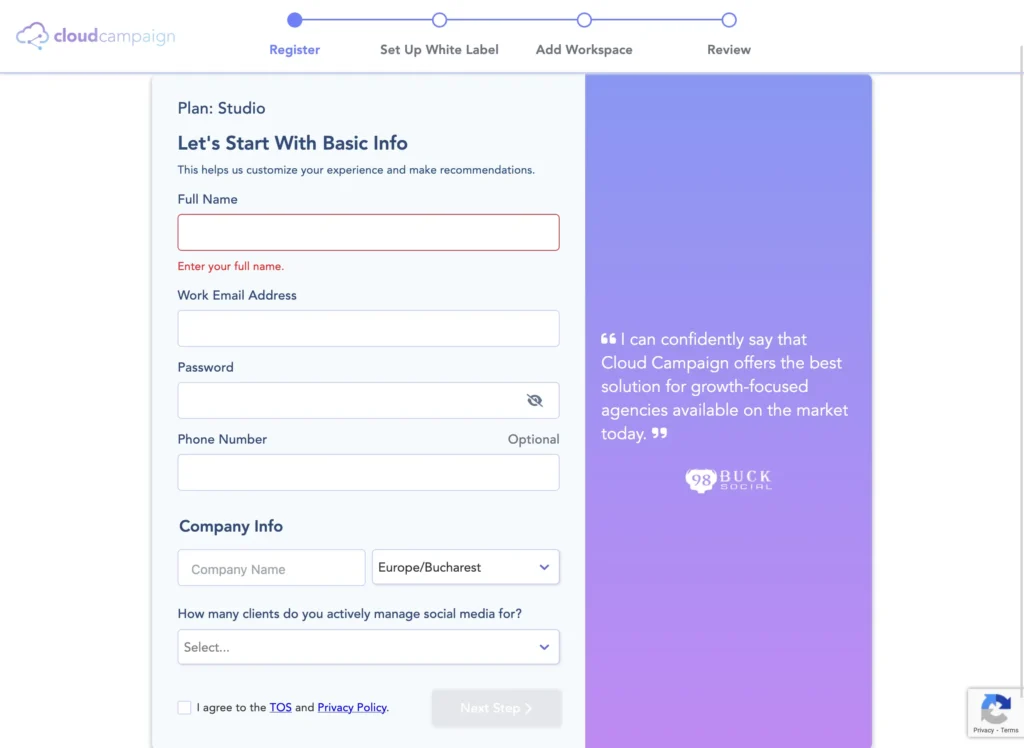
Why choose CloudCampaign?
CloudCampaign isn’t just another social media scheduling tool thrown into an already crowded market as it was specifically designed from the ground up in 2017 to solve the unique challenges that marketing agencies and freelancers face when managing multiple client accounts.
Founded by Ryan Born and Ross Gray in Boulder, Colorado, CloudCampaign emerged from a critical observation: while 79% of brands were hiring marketing agencies, these agencies were being forced to use brand-focused solutions that didn’t address their multi-client workflows. This gap in the market became CloudCampaign’s opportunity to shine.
What makes CloudCampaign stand out is its agency-first philosophy. Every feature, from unlimited users to white-label branding, was built with the understanding that agencies need to manage multiple client workspaces efficiently without per-seat pricing that punishes growth. The platform supports major social networks including Facebook, Instagram, LinkedIn, Twitter (X), TikTok, Pinterest, YouTube, and Google My Business, giving agencies comprehensive coverage across the social media landscape.
For agencies looking to streamline workflows, impress clients with professional branded experiences, and scale their operations without operational headaches, CloudCampaign positions itself as the comprehensive operating system you need.
CloudCampaign’s Pros and Cons
Strong points
CloudCampaign’s white-label capabilities are genuinely best-in-class. You can customize everything—from the domain name (like dashboard.youragency.com) to the logo, colors, email templates, and even client-facing reports. This level of branding control means your clients never see “CloudCampaign” anywhere in their experience, which builds tremendous trust and makes your agency look polished and professional.
The unlimited users feature across all plans is a game-changer for agencies. Unlike competitors like Hootsuite that charge per seat, CloudCampaign allows you to add unlimited team members and clients at no additional cost. This pricing structure means your costs remain predictable as you scale, which is critical for maintaining healthy profit margins.
Client approval workflows are exceptionally smooth with CloudCampaign. The platform provides shareable approval links that clients can access without logging in, making it incredibly easy for clients to review and approve content with a single click. This eliminates the endless email chains and spreadsheet chaos that used to plague agency workflows.
CloudCampaign’s content automation and scheduling features save agencies tremendous time. You can bulk-create content, set up recycling schedules for evergreen posts, automate publishing with drip campaigns, and integrate directly with Canva for seamless design workflows. The visual calendar interface makes it easy to see your entire content strategy at a glance.
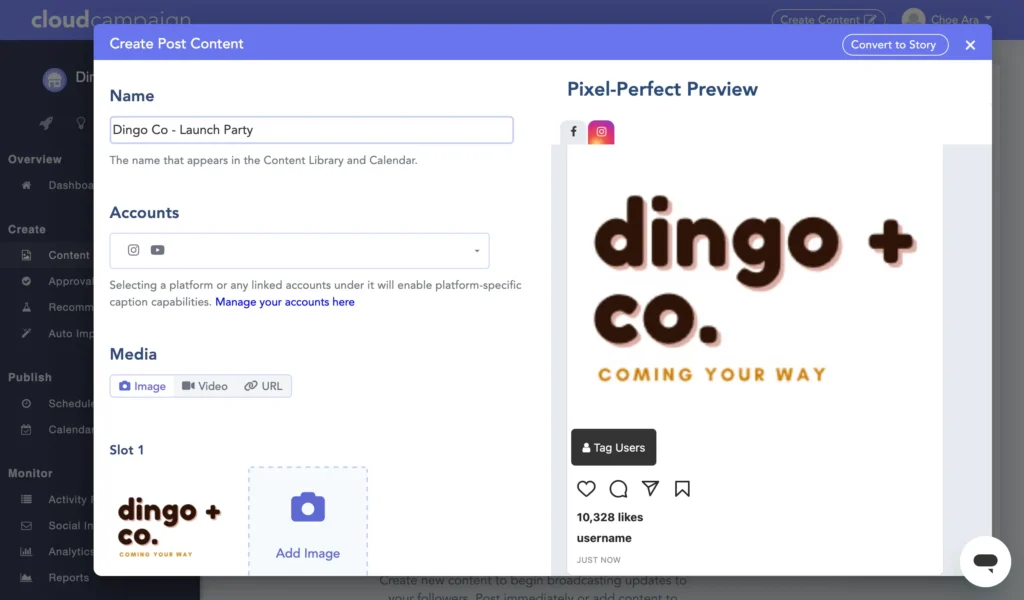
The AI caption generator powered by ChatGPT technology is genuinely useful. Called CaptionAI, it generates up to 10 caption variations per platform, automatically adjusts for character limits, and offers customizable tones to match your brand voice. It’s included free with all paid plans and offers unlimited usage, making it a valuable tool for overcoming writer’s block and scaling content production.
Customer support consistently receives praise from users. CloudCampaign provides exceptional, responsive support with a dedicated account manager for Studio and Agency plans, VIP chat assistance, and comprehensive onboarding. Users frequently mention that the support team goes above and beyond to help resolve issues quickly.
Plus, further automation like auto-import helps save time.
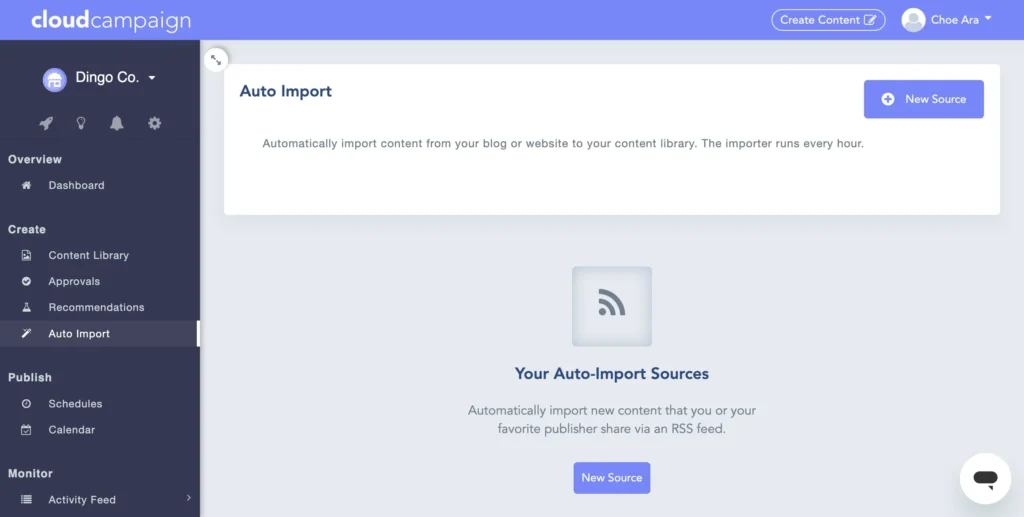
Weaknesses
The pricing structure presents a significant barrier for growing agencies. There’s a massive jump from the Freelancer plan at $34/month to the Studio plan at $249/month, a difference that can be prohibitive for small agencies or freelancers trying to scale.
One user on Capterra complained: “As an agency, I have to pay $200/month or so for 5 client accounts… even though I’m really only using 1 right now”.
Analytics and reporting are an area where CloudCampaign falls short of competitors. Multiple users report that the analytics “really STINK STINK STINK” and that the reporting features are insufficient for detailed performance tracking.
The analytics show highest-performing posts well, but viewing comprehensive performance data for all posts requires significant manual effort. Some users also note occasional mismatches between CloudCampaign’s reported numbers and native platform analytics, particularly for TikTok.
The lack of a mobile app is a notable limitation in 2025. For social media managers who need to manage content on the go, this absence creates friction in their workflows. Competitors increasingly offer robust mobile experiences, making this gap more noticeable.
Technical glitches occasionally disrupt workflows. Users report issues with posts failing to publish, images not uploading correctly, Instagram Stories having limited functionality, and social accounts frequently disconnecting and requiring re-authentication. While these issues are usually resolved with support assistance, they can disrupt campaign schedules.
The social inbox has received mixed feedback. While it centralizes messages and comments from multiple platforms, some users report it has bugs and makes it difficult to achieve “inbox zero”. The feature needs refinement to match the efficiency of dedicated engagement tools.
Platform-specific limitations frustrate some users. For instance, you cannot post interactive Instagram Stories with polls, questions, or links directly from the platform, and there’s limited support for some newer features on platforms like Threads.
CloudCampaign’s use cases
CloudCampaign excels as a solution for marketing agencies managing multiple client accounts across diverse industries. The platform’s workspace separation feature ensures that each client’s content, team members, and social accounts remain siloed from others, preventing the nightmare scenario of posting client A’s content to client B’s account. Over 3,000 agencies use CloudCampaign to streamline their social media operations.
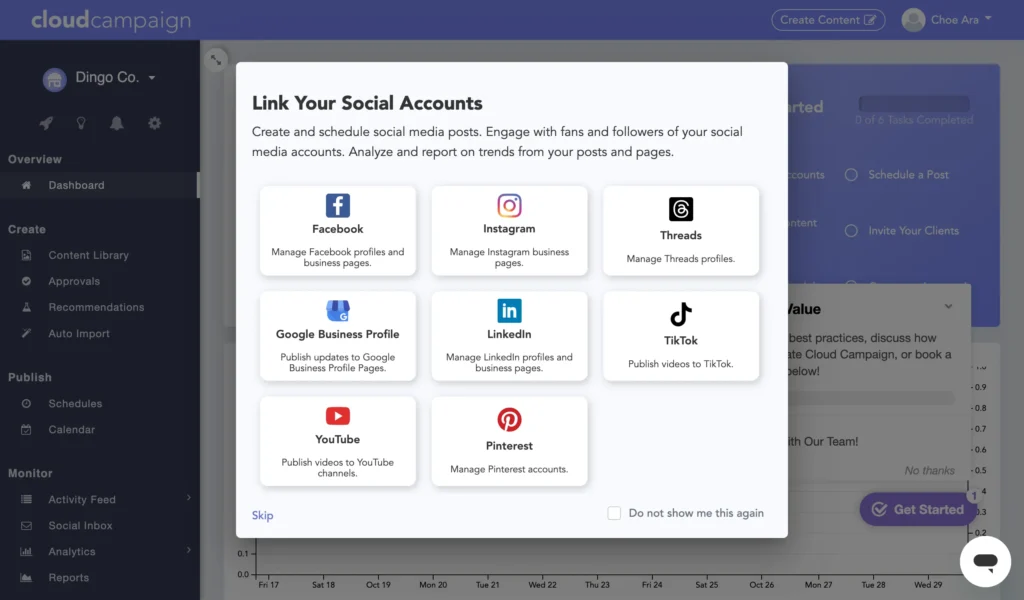
Freelance social media managers benefit from CloudCampaign’s ability to present a professional, branded experience even if you’re a one-person operation. The white-label capabilities make you look like a full-service agency, which helps justify premium pricing and win larger contracts. The Freelancer plan starting at $34/month provides an affordable entry point for solopreneurs building their client base.
Growing agencies find tremendous value in CloudCampaign’s scalability. The unlimited users feature means you can bring on new team members as you expand without worrying about per-seat costs eating into your margins. The platform supports managing anywhere from a handful of clients to dozens of brands simultaneously.
Franchise businesses leverage CloudCampaign to maintain brand consistency across multiple locations while allowing individual franchisees to customize content for their local markets. The centralized content library and approval workflows ensure brand guidelines are maintained while empowering local autonomy.
SaaS companies are increasingly using CloudCampaign’s OEM (white-label embedded) solution to add social media management capabilities directly into their own products. This B2B2C model has been CloudCampaign’s fastest-growing segment, achieving over 400% year-over-year growth in 2024.
For consultants and marketing professionals who provide strategic guidance but want to empower clients to manage their own day-to-day posting, CloudCampaign’s white-label client portal provides the perfect solution. You can sell access to the branded platform as an additional revenue stream while maintaining oversight of strategy and performance.
CloudCampaign’s top 3 features
1. Comprehensive White-Label Branding
CloudCampaign’s white-label branding capabilities extend far beyond logo placement, offering complete customization including custom domain setup (dashboard.youragency.com), full color and logo customization, branded email notifications, and client-facing reports.
The seamlessness ensures clients see only your agency’s branding with zero CloudCampaign mentions, creating brand equity and justifying premium pricing.
One-click white-label reports automatically carry your branding and can be scheduled for automatic delivery, saving hours of monthly work. This level of control is invaluable for agencies building long-term relationships and maximizing client lifetime value.
2. Multi-Client Workspace Management
The multi-client workspace architecture isolates each client’s social accounts, team members, content library, approval workflows, and analytics, preventing accidental content cross-posting. Unlimited team members within workspaces have granular permission controls, while clients can review calendars, approve posts, and view real-time analytics without accessing internal workflows.
A simple dropdown enables seamless workspace switching with remembered settings for each client. Content libraries store brand-specific assets, hashtags, and messaging templates, while workspace-level integrations with Canva, Google Drive, and RSS feeds streamline content creation.
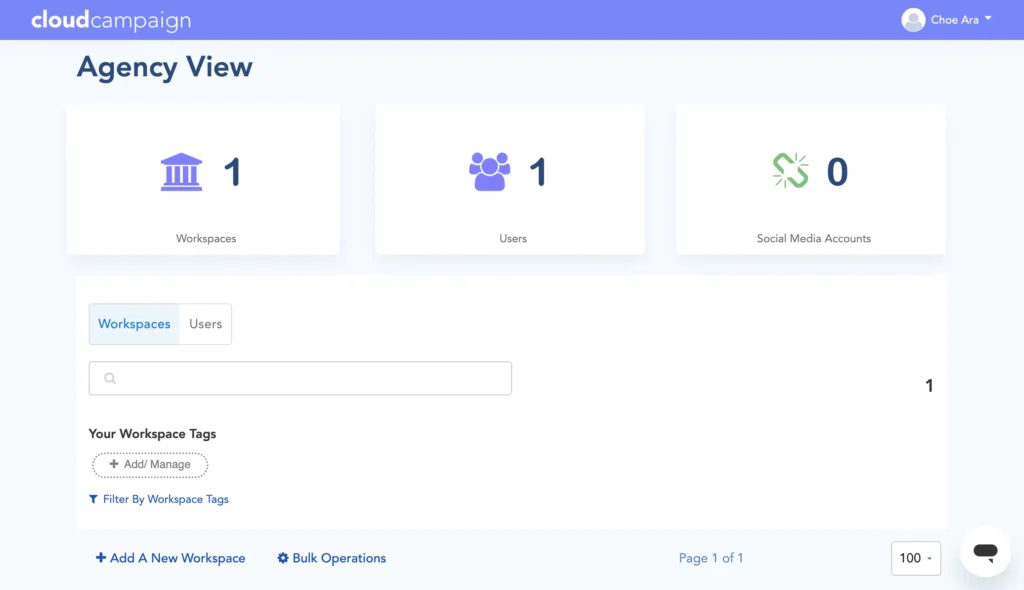
3. AI-Powered CaptionAI Writing Assistant
CaptionAI, CloudCampaign’s ChatGPT-powered caption generator, creates up to 10 platform-optimized variations from brief descriptions. Its platform intelligence automatically adjusts captions for Facebook, Instagram, LinkedIn, Twitter, and others, following each network’s best practices and character limits.
Tone customization offers professional, casual, enthusiastic, or custom brand voice options. Built directly into the content workflow with unlimited usage across all paid plans, CaptionAI eliminates copying between tools and dramatically accelerates batch content creation, allowing agencies to generate caption options instantly and focus energy on strategy.
What users say about CloudCampaign
CloudCampaign earns 4.9 out of 5 stars on Capterra, with users praising its seamless interface and gentle learning curve. Reviewers highlight exceptional customer support—described as “seriously awesome” and “very responsive”—with dedicated account managers providing strategic guidance for higher-tier plans.
However, user feedback reveals notable pain points. Analytics frustration appears repeatedly, with users emphasizing that comprehensive performance insights require significant manual effort, forcing those needing advanced competitive analysis to supplement with additional tools.
A substantial pricing gap between Freelancer ($49) and Studio ($229) plans creates challenging decision points for growing agencies, with some questioning whether the cost increase justifies the value if they haven’t adopted all advanced features.
Technical reliability is mixed: while many report smooth operations, others experience occasional post publishing failures, image upload issues, and social account disconnections requiring re-authentication—stressful during time-sensitive campaigns.
White-label branding emerges as a major strength, with users noting it helps agencies maintain professional appearances and improves client information-gathering speed.
On G2, CloudCampaign maintains strong ratings, with reviewers emphasizing that it has “completely transformed” client approval workflows and represents a dramatic improvement over spreadsheet-based processes.
CloudCampaign vs. the Competition
When compared to major competitors like Hootsuite, CloudCampaign offers significant advantages in pricing and agency-specific features. Hootsuite’s Professional plan starts at $99/month for a single user, while CloudCampaign’s Freelancer plan begins at $34/month. More importantly, Hootsuite charges per user, meaning costs escalate rapidly as teams grow, whereas CloudCampaign includes unlimited users on all plans.
However, Hootsuite offers more advanced social listening capabilities and a broader ecosystem of third-party integrations (150+ apps in their App Directory). For large enterprises needing sophisticated social listening and extensive platform support, Hootsuite’s higher price may be justified.
Buffer takes a simpler, more streamlined approach than CloudCampaign and is often praised for its clean, intuitive interface. Buffer’s pricing is more affordable for individuals and small teams, but it lacks CloudCampaign’s white-label capabilities and multi-client workspace architecture. For agencies specifically, CloudCampaign provides much more robust client management features.
Sprout Social competes in CloudCampaign’s space with powerful analytics and comprehensive social engagement tools. Sprout’s analytics are notably more advanced than CloudCampaign’s, providing deeper insights and more actionable intelligence. However, Sprout Social’s pricing is significantly higher, with plans starting at $249/month, making it less accessible for smaller agencies and freelancers. CloudCampaign provides better value for agencies focused primarily on content scheduling and client management rather than advanced analytics.
Agorapulse offers similar agency-friendly features with strong social inbox and engagement capabilities. Many users find Agorapulse’s social inbox more polished than CloudCampaign’s. However, CloudCampaign’s white-label options are more comprehensive, and the pricing remains competitive, with Agorapulse’s comparable plans typically costing more.
SocialPilot presents an interesting alternative for budget-conscious agencies. It offers many similar features at potentially lower per-client costs, with bulk scheduling for up to 500 posts and solid white-label functionality. However, CloudCampaign’s interface is generally considered cleaner and more user-friendly, and the unlimited users feature provides better scalability.In the white-label space specifically, competitors like OnlySocial, Sendible, and SocialChamp offer similar branding capabilities. OnlySocial is more cost-effective at scale; however, CloudCampaign’s maturity as a platform and its strong customer support give it an edge in reliability and user experience.
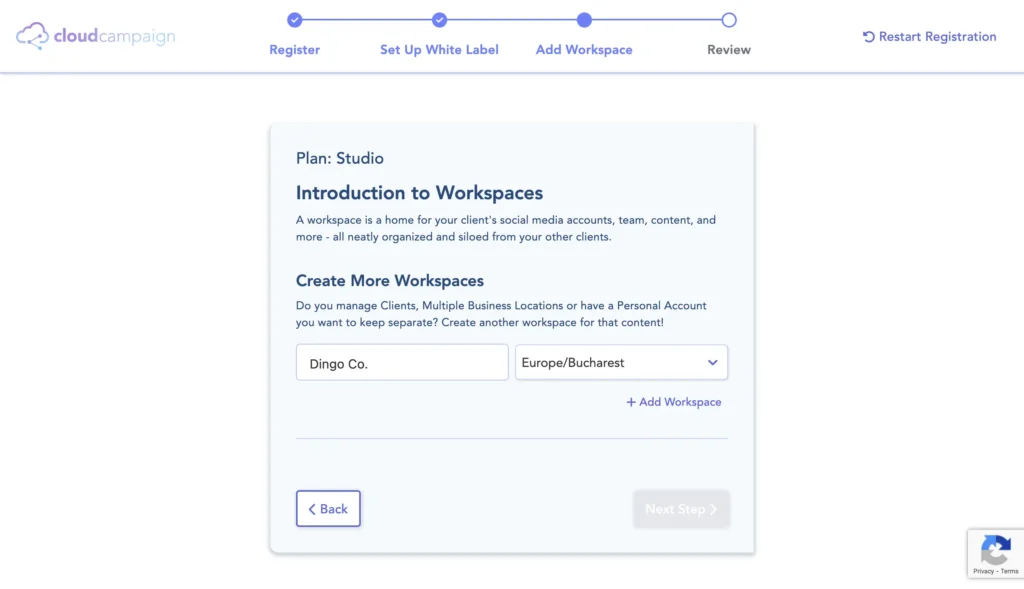
The verdict: CloudCampaign sits in a sweet spot for agencies that prioritize white-label branding, client workflow management, and scalable pricing over advanced analytics and social listening. It’s not the cheapest option, nor the most feature-rich, but it offers an excellent balance of agency-specific capabilities at a reasonable price point.
Price and cost comparisons
CloudCampaign’s workspace-based pricing fundamentally differs from per-seat models. The Freelancer Plan ($34/month or $28 annually) includes 1+ workspace with 7 social accounts per client, offering basic features like scheduling, approvals, community management, and reporting—ideal for solo freelancers.
The Studio Plan ($149/month or $124 annually) supports 5+ workspaces with unlimited social accounts and full white-label capabilities including custom domains, branded dashboards, dedicated account managers, and phone support—where the platform becomes truly powerful for growing agencies.
The Agency Plan ($249/month or $207.50 annually) adds advanced white-label features, paid social advertising reporting, and priority support for established multi-client operations.
All plans include unlimited internal and client users—a massive advantage over competitors. Hootsuite’s $99/month per-user Professional plan costs $495/month for five team members before additional features. CloudCampaign offers a 14-day free trial with flexible plan changes and pro-rated adjustments.
The platform bundles features typically requiring multiple subscriptions: scheduling, approval workflows, branded reporting, analytics, social inbox, AI caption generation, and design tool integrations. For five brands, CloudCampaign undercuts Hootsuite, Sprout Social, and Buffer’s limited features. However, the gap between Freelancer and Studio plans creates friction for growing freelancers managing 2-4 clients who need white-label capabilities but can’t justify the premium.
Privacy and security
CloudCampaign implements industry-standard security with robust encryption for data at rest and in transit. The company’s privacy policy (last updated April 2018) outlines commitment to protecting users and ensures transparency regarding data collection, use, and storage.
Agencies can implement role-based access controls with granular permissions preventing unauthorized access to sensitive information. User authentication protects accounts, though two-factor authentication details aren’t prominently documented, which means that agencies handling sensitive client data should confirm specific security features by plan tier.
Data backup and recovery protections safeguard content libraries and analytics, though agencies should maintain independent backups and disaster recovery procedures. Workspace architecture isolates each client’s data, content, and credentials, reducing cross-contamination risks. However, occasional Instagram re-authentication requirements create frustration and potential vulnerabilities if not caught before post failures.
CloudCampaign lacks publicly detailed information about hosting providers, data center locations, and specific security certifications (SOC 2, ISO 27001, GDPR compliance). Agencies with enterprise clients requiring comprehensive security documentation should contact CloudCampaign directly for attestations.
Best practices include reviewing security documentation, understanding tier-level protections, implementing strong passwords, limiting permissions, and conducting regular audits. Importantly, while CloudCampaign implements reasonable SaaS security measures, no system is entirely immune to risk. Agencies must maintain independent security protocols and recognize shared responsibility for data protection when using third-party platforms.
Product updates and releases
CloudCampaign releases updates every few weeks with transparent roadmap communication. Recent 2024-2025 additions include built-in image editor, refreshed content workflow, Meta Threads scheduling, enhanced AI Caption Generator, improved social inbox with AI-powered responses, and better white-label customization.
Through Product Hunt and beta testing, the company prioritizes early user feedback to solve genuine workflow challenges. Integrations span Canva, Google Drive, RSS feeds, and Shopify. The OEM/embedded solution for SaaS achieved 400%+ growth in 2024, enabling companies to embed CloudCampaign capabilities under their branding.
Future development focuses on AI features, workflow automation, enhanced analytics, and emerging social network support. Consistent release cadence and user responsiveness indicate continued improvements through 2025 and beyond.
Company evolution
Founded in 2017 by Ryan Born and Ross Gray in Boulder, Colorado, CloudCampaign identified a critical gap: agencies lacked multi-client tools despite 79% of brands hiring them. This shaped the company’s agency-first DNA.
Early adoption accelerated through Product Hunt. In January 2020, Access Venture Partners funded the company; despite launching pre-pandemic, it thrived amid remote work’s surge. May 2021 brought a $5 million Series A.
Post-Series A: 200% revenue growth, 420 new clients, and 3 million published posts. By 2024, CloudCampaign supported 1,000+ agencies managing 15,000+ brands with ~30 employees.
The OEM solution for SaaS became the fastest-growing segment in 2024, achieving 400%+ growth and powering 70,000+ small businesses. The company prioritizes remote-first culture and expanded its mission to “the operating system for marketing agencies,” with potential project management and invoicing expansion.
Final verdict
CloudCampaign is ideal for agencies managing 5-20 clients valuing unlimited users, white-label branding, and streamlined workflows. However, analytics lag Sprout Social and Hootsuite, and the pricing gap between Freelancer ($34) and Studio ($149) disadvantages growing solopreneurs. Occasional technical glitches and no mobile app present friction.
CloudCampaign outperforms enterprise alternatives ranging between $700 to 1,000/month. White-label capabilities worth tens of thousands in development costs make it attractive, though budget-conscious high-volume agencies may find better per-client economics elsewhere.
For growing agencies prioritizing client experience, branding, and efficiency over advanced analytics, CloudCampaign delivers compelling value. Use the 14-day free trial to evaluate. Solo freelancers or agencies needing enterprise analytics should explore alternatives.
Conclusion
CloudCampaign has carved out a distinctive position in the crowded social media management landscape by staying laser-focused on what agencies actually need. While it may not be the cheapest option or the most feature-laden platform, it offers a thoughtful balance of white-label branding, multi-client workflow management, and scalable pricing that resonates with its target audience.
The company’s growth trajectory (from a 2017 startup to a platform supporting thousands of agencies and tens of thousands of businesses) validates the agency-first approach.
As social media management continues evolving in complexity, CloudCampaign’s commitment to solving agency-specific challenges positions it well for continued relevance in 2025 and beyond. Whether it’s right for your agency depends on your specific needs, client count, and priorities—but it’s certainly worth the free trial to find out.











